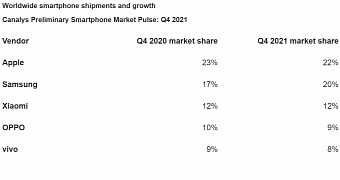The iPhone keeps selling like hotcakes all over the world, with statistics shared by Canalys indicating Apple’s device was the most popular smartphone in the fourth quarter of 2021.
More specifically, the Cupertino-based tech giant accounted for no less than 22 percent of the phone sales worldwide, which means that more than 1 in 5 phones solid during the quarter was an iPhone.
However, Apple’s market share fell from 23 percent in Q4 2020 to 22 percent in Q4 2021, mostly as Samsung managed to recover and secure the runner-up spot with a market share increase from 17 percent to 20 percent.
Xiaomi continued to be the number three in the charts with a 12 percent share, followed by OPPO and vivo.
“Apple is back at the top of the smartphone market after three quarters, driven by a stellar performance from the iPhone 13,” said Canalys Analyst Sanyam Chaurasia.
“Apple saw unprecedented iPhone performance in Mainland China, with aggressive pricing for its flagship devices keeping the value proposition strong. Apple’s supply chain is starting to recover, but it was still forced to cut production in Q4 amid shortages of key components and could not make enough iPhones to meet demand. In prioritized markets, it maintained adequate delivery times, but in some markets its customers had to wait to get their hands on the latest iPhones.”
The shortage is here to stay
Overall, the market increased just 1 percent, mostly as companies out there, including Apple itself, are struggling with the component shortage.
“Component manufacturers are eking out additional production, but it will take years for major foundries to significantly increase chip capacity. Smartphone brands are already innovating to make the most of their circumstances, tweaking device specs in response to available materials, approaching emerging chipmakers to secure new sources for ICs, focusing product lines on the best-selling models and staggering new product releases. These practices lend an advantage to larger brands, and they are set to stay for the short term, as bottlenecks will not ease until the second half of 2022,” Canalys VP Mobility Nicole Peng says.

 14 DAY TRIAL //
14 DAY TRIAL //